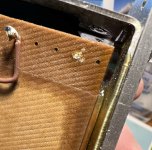The important thing is if the wire leading to the stud is still there. You can use a neighbor hole and try inserting/pressing a standard board grade pin through, them solder the wire. Extend it if you have to.
As I see it, the issue is getting TO that super thin wire behind the cardboard. As the transformer is banded into its steel bracket and leaves no access to what remains of the tiny wire to stud connection.
Do you think I could solder to what’s left of the stud? I’m worried about heating the stud remains too hot and desoldering that super thin wire connected to it 🤔
Maybe I could carefully dig out what remains and see about some sort of new joint. DANG! It’s so tiny/thin!
Do you think I could solder to what’s left of the stud? I’m worried about heating the stud remains too hot and desoldering that super thin wire connected to it 🤔
Maybe I could carefully dig out what remains and see about some sort of new joint. DANG! It’s so tiny/thin!
Postage costs to Sweden might be inhibitive, but perhaps the factory could fix it.
There was also a thread about fixing delay line inductors of Quad ESL-63 planar speakers, that also use super thin wires. It could give some idea.
There was also a thread about fixing delay line inductors of Quad ESL-63 planar speakers, that also use super thin wires. It could give some idea.
I would indeed solder to the stud, and lead this wire to another stud, so you don't have to touch the "fix" again. If the wire gets loose I would try to drill out the hole to see if I can get to the wire through it. It goes without saying that all with uttermost care 🙂
Not that it helps after the accident happened but here is how I avoid similar incidents with Lundahls:
https://www.diyaudio.com/community/...hl-broken-transformer-pin.366828/post-6505179
https://www.diyaudio.com/community/...hl-broken-transformer-pin.366828/post-6505179
My first attempt at soldering to the tiny amount that is left in it's hole... did not work but I did take TNT's advice and am contacting Lundahl 🙂
Lundahl indicated I should cut away cardboard to reveal as much as the remaining wire as possible and resolder. This has been echoed by a friend who had one of his Lundahl chokes break a stud. So what do I do?
I go back into the amp, pull the IT and cut away the bad first attempt and try to determine why it failed. I used solder wick to clear away bits of metal and flux.
I don't have very good magnification but after cleaning what I thought I saw was a ring left in the hole of the cardboard as if the stud were mounted to a ring and the ring had that tiny wire soldered to it - an in-between like that would make soldering/construction sense. (I have a question in to Lundahl but the person who handles questions is out for a week, they say.). Anyway, that hole/ring presented me something better to solder to this time and this time it worked!
I can recommend to anyone working with Lundahl transformers to go easy on the connecting wires. I thought 20ga was good but I'd say 23ga makes more sense and too, I'd choose silicone jacketed wire. I'm pretty sure it was the torque of a long 20 gauge wire that snapped the stud/ connection. I am liking the soft silicon hight temperature wire I have been using lately. I may give up on the military teflon jacketed stuff.
Cheers!
I go back into the amp, pull the IT and cut away the bad first attempt and try to determine why it failed. I used solder wick to clear away bits of metal and flux.
I don't have very good magnification but after cleaning what I thought I saw was a ring left in the hole of the cardboard as if the stud were mounted to a ring and the ring had that tiny wire soldered to it - an in-between like that would make soldering/construction sense. (I have a question in to Lundahl but the person who handles questions is out for a week, they say.). Anyway, that hole/ring presented me something better to solder to this time and this time it worked!
I can recommend to anyone working with Lundahl transformers to go easy on the connecting wires. I thought 20ga was good but I'd say 23ga makes more sense and too, I'd choose silicone jacketed wire. I'm pretty sure it was the torque of a long 20 gauge wire that snapped the stud/ connection. I am liking the soft silicon hight temperature wire I have been using lately. I may give up on the military teflon jacketed stuff.
Cheers!
- Home
- Amplifiers
- Tubes / Valves
- broken stud on Lundahl interstage transformer
